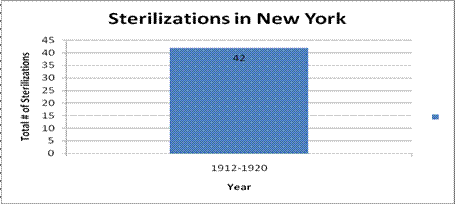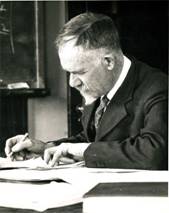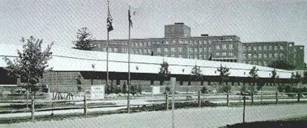New York
Number of victims
A total of 42 sterilizations took place in New York, almost all of which were performed on women who were considered mentally ill. In terms of the total number of sterilization performed under sterilization law, New York ranks 28th among the states.
Period during which sterilizations occurred
All of the sterilizations under New York’s sterilization law occurred after its passage in 1912 and before its repeal in 1920 (Paul, p. 560).
Temporal pattern of sterilizations and rate of sterilization

After the sterilization law was passed in 1912, a total of 42 sterilizations took place over a 9-year period, averaging fewer than 5 sterilizations per year. No sterilizations occurred after 1920. The number of sterilizations per 100,000 residents per year was less than 0.5.
Passage of laws
The law was passed on April 16, 1912. The lower courts of New York declared this sterilization law unconstitutional in March 1918, at which time the sterilizations stopped. This ruling was made in the case Osborn v. Thompson, where Osborn was the plaintiff and Thompson the defendant from the Board of Examiners. Osborn was a “feeble-minded” inmate of an asylum who was “voluntarily” sterilized under the law. The Court made its decision because the law did not apply to people outside of state asylums who may have the same “defects” as Osborn, a violation of the Fourteenth Amendment (Paul, pp. 560-63). Before the litigation reached New York's highest court, the sterilization law was repealed by the legislature in May, 1920. New York was the eighth state to pass a sterilization law in the United States (Laughlin, p. 26).
Precipitating Factors and Processes
New York's Ellis Island is renowned for having been the gateway to the United States for millions of immigrants in the nineteeneth and twentieth centuries. Immigration, as a major social phenomenon and issue, is ingrained in the history of the state. In the early twentieth century, partly in response to a massive influx of immigrants, the Americanization movement was gaining ground in New York. This movement stressed the assimilation and naturalization of foreign-born individuals. The New York Bureau of Industries and Immigration was the first immigrant social welfare program in the nation but in 1913 Marian Clark, a eugenicist, took over as chief investigator of the bureau. She attemped, without much success, to graft eugenics onto the Americanization movement (Ziegler-McPherson, pp. 54-55).
Clark
advocated immigration restriction to shape American culture; she
supported exclusion and sterilization of "defective" aliens and
citizens, believing that the United States could develop a healthier
and stabler society as a result. She even attempted, unsuccessfully, to
enlist the aid of eugenics leader Charles Davenport to "develop a plan
whereby the state might be relieved of the burden of not only
deportable insane aliens, but also alien criminals and other
dependants." Despite Clark's conviction to eugenics through immigration
restriction, only a few hundred to a thousand "defective" aliens were
deported each year before 1921 because of lack of governmental funding.
Nonetheless, immigration was a major concern in both the
Americanization and eugenics movements of New York and, though they
were not compatible, they both grew in the following decades
(Ziegler-McPherson, p. 57).
Groups identified in the law
“Inmates of State hospitals for the insane, State prisons, reformatories, and charitable institutions, and rapists, and confirmed criminals in penal institutions” were eligible for sterilizations under the decision of the Board of Examiners (Laughlin, p.10).
Process of the law
A board of examiners reviewed the cases. It consisted of one skilled surgeon, one experienced neurologist, and one skilled medical practitioner. This board made a majority decision after examining the mental and physical condition of the subject. Other factors considered before sterilization were family history and consequences of the subject's procreation. Unauthorized operations were considered a misdemeanor except in the case of medical necessity (Laughlin, p.10).
Major proponents
Charles Davenport:
 (Photo origin: American Philosophical Society, available at http://www.amphilsoc.org/library/mole/d/davenport.htm)
(Photo origin: American Philosophical Society, available at http://www.amphilsoc.org/library/mole/d/davenport.htm)
Charles B. Davenport was a major figure in the American
eugenics movement. Davenport was born in Brooklyn, New York, in 1866 and
received a home education from his father until 13. He received an engineering
degree from Brooklyn Polytechnic Institute in 1887. Following this he received
an A.B. degree in zoology at Harvard in 1889. He enrolled in Harvard graduate
school for his Ph.D. and received it in 1892. Davenport served as an instructor
at Harvard for a short time following his graduation.
Davenport took up a permanent position as director of Cold Spring Harbor, New York, in 1904. The Eugenics Record Office was an addition to the Cold Spring project that Davenport directed from its founding in 1910.
His work Race Crossing in Jamaica (1929) gave evidence for the biological and cultural degradation from inbreeding between black and white populations. This study was attacked for drawing conclusions that stretched beyond the data he presented. Some eugenicists considered it “scientific racism” (Allen, p. 227). He retired in 1934 as a member of the National Academy of Sciences. Charles Davenport died in 1944.
“Feeder institutions” and institutions where sterilizations were performed
 (Photo origin: DOCS Today, available at http://www.geocities.com/MotorCity/Downs/3548/facility/gowanda.htm)
(Photo origin: DOCS Today, available at http://www.geocities.com/MotorCity/Downs/3548/facility/gowanda.htm)
Gowanda State
Hospital: Collins, Erie County: In 1894, the state took 500 acres of
property from Quaker settlers for construction of a state hospital for the
insane. The first building was completed in 1898 and is still in use today.
Nearly 100 more buildings would be erected as the institution census rose to
over 4,000 psychiatric patients. In 1994, the hospital was converted into a state
correctional facility (Gowanda Prison). After housing renovations and the
construction of a Special Housing Unit in 1995, the capacity rose to 2,300 men,
making it the second largest correctional facility in New York State (“Gowanda”). During the eugenics campaign, the Gowanda
State Hospital sterilized the most people in New York. In total, 29 people were
sterilized, all women (Laughlin, p. 81). There is no mention of a eugenics
history from the NY State Department of Correctional Services.
 (Photo origin: Kowsky, Francis R, A Towering Masterpiece, available at
http://preserve.bfn.org/bam/archs/rich/statekowsky/)
(Photo origin: Kowsky, Francis R, A Towering Masterpiece, available at
http://preserve.bfn.org/bam/archs/rich/statekowsky/)
Buffalo State Hospital, Buffalo: In 1870, Governor Hoffman made plans for the institution that was to occupy 200 acres of land in north Buffalo. The entire complex of eleven buildings was not finished until 1886. This hospital, constructed of brick and stone was called “one of the most magnificent buildings erected in the United States in the 19th century”. The brick wards were demolished in 1960's and the Kirkbride building was vacated of all patients in 1974, and one year later the institute became known as Buffalo Psychiatric Center, which is still active to this day (Kowsky).
During the eugenics campaign, the Buffalo
State Hospital sterilized all but one remaining person in New York. In total,
12 people were sterilized, all women (Laughlin, p.81). There is no mention of a
eugenics history on the corresponding website of the New York State Office of
Mental Health (New York State Office of Mental Health).
Other important institutions
 (Photo origin: New York Biotechnology Association, available at http://www.nyba.org/tech_transfer_directory.php)
(Photo origin: New York Biotechnology Association, available at http://www.nyba.org/tech_transfer_directory.php)
The only sterilization of a male under Massachusett's sterilization law occured in the Auburn State Prison and was apparently therapeutic, in response to a diseased testical (Paul, p. 561).
Cold Spring Harbor began as a small research laboratory in 1890 on Long Island, New York. Today it is a private, non-profit institution with research programs in cancer, neurobiology, and genetics.
In 1904, Charles Davenport persuaded the Carnegie
Institution of Washington to fund a genetic research facility at the Cold
Spring Harbor site. This program was the Station for Experimental Evolution
(SEE) that later grew to include the Eugenics Record Office (ERO) in 1910 (Cold Spring Harbor Laboratory).
The ERO was the only eugenics institution in the country with a building, research facilities, and a paid staff. The ERO became a meeting place for eugenicists, a collection facility for eugenics records, and the home of eugenical publications. With two of America’s best-known eugenicists: Davenport and Harry Laughlin, the ERO was a “platform from which popular eugenic campaigns could be launched” (Allen, p. 226).
Other specific functions of the ERO were listed by Laughlin in his first report in 1913: to index the traits (physical, mental, social, etc.) in American families, study the hereditary consequences of marriages, investigate the inheritance of human traits, and to advise in the eugenical fitness of proposed marriages. More functions were to train fieldworkers to gather eugenical data, encourage new eugenics centers for research and education, and to publish the results (Allen, pp. 238-242).
When the ERO began its national eugenics campaign in the 1920s popular culture took notice. Eugenicists used state fairs to establish cultural power to define what was normal and abnormal. The ERO sponsored Fitter Family Contests at state fairs with the goal of producing the ‘fittest’ (or ‘whitest’) families possible. These families would be used as examples of genetic purity among Anglo-Americans (Emin, p. 2).
To collect the data from American families, the ERO used a ‘trait book’ to lo list most all human traits imaginable. They used 3x5 index cards to classify conditions using the Dewey Decimal System (example # 4598), where each digit signifies a different aspect of the condition. About 537,000 cards had been made by 1918. This detailed system was used so that researchers could follow the same traits through a variety of family lines (Allen, p. 239).
During the early twentieth century, the rich displayed their wealth at Coney Island, New York where entertainment including amusement parks and human spectacle presentations was provided. Scientists from the ERO made special trips to Coney Island to photograph and document sideshow performers beginning in 1910. These performers were curious spectacles for the crowds, but the eugenicists saw their disabilities as bad heredity. Davenport began observing freak shows for specimens in his scientific theories. Examples of such specimens were the ‘snake-skinned boy,’ the lion faced boy, and Chief Pantagal. Pantagal was a native jungle man who bit off and ate snake and chicken heads in his performance. ERO agents went as far as analyzing samples of his hair for heredity research. With their reports and photographs, the ERO hoped to eliminate deviant bodies to ‘normalize’ the population of the U.S (Emin, pp. 1-7).
The ERO closed its doors in 1939 after the Carnegie Institution withdrew all funding after reviewing the Office’s work. Their reports and articles have since been discredited, no longer considered scientific facts (Cold Spring Harbor Laboratory).
Bibliography
Allen, Garland E. 1986. “The Eugenics Record Office at Cold Spring Harbor, 1910-1940: An Essay in Institutional History.” Osiris 2: 225-264.
“Charles B. Davenport Papers.” American Physiological Society. Available at <http://www.amphilsoc.org/library/mole/d/davenport.htm>.
Cold Spring Harbor Laboratory. 2008. “A Brief History of Cold Spring Harbor Laboratory.” Available at <http://www.cshl.edu/about/history/index.html>.
Davenport, Charles B., and Morris Steggerda. 1929. Race Crossing in Jamaica. Washington, D.C.: Carnegie Institution of Washington.
Emin, Tanfer. 2001. “Freaks and Geeks: Coney Island Sideshow Performers and Long Island Eugenics, 1910-1935.” Long Island Historical Journal. 14, 1-2: 1-14.
“Gowanda.” 1999. DOCS Today (November). Available at <http://www.geocities.com/MotorCity/Downs/3548/facility/gowanda.htm>.
Kowsky, Francis R. 2000. “A Towering Masterpiece: H. H. Richardson's Buffalo State Hospital.” Available at <http://preserve.bfn.org/bam/archs/rich/statekowsky/>.
Laughlin, Harry H. 1922. Eugenical Sterilization in the United States. Chicago: Municipal Court of Chicago.
New York State Office of Mental Health. “Buffalo Psychiatric Center.” Available at <http://www.omh.state.ny.us/omhweb/facilities/bupc/facility.htm>.
Paul, Julius. 1965. "'Three Generations of Imbeciles Are Enough': State Eugenic Sterilization Laws in American Thought and Practice." Washington, D.C.: Walter Reed Army Institute of Research.
Ziegler-McPherson, Christina A. 2009. Americanization in the States. Gainesville, FL: University Press of Florida.